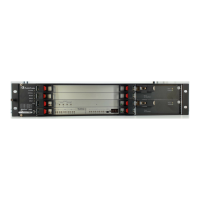Version 7.0 557 Mediant 3000
User's Manual 28. SBC Overview
device removes users from the database only when their registration expiry time is reached
(with the additional grace period, if configured).
28.4.5 Registration Restriction Control
The device provides flexibility in controlling user registrations:
Limiting Number of Registrations: You can limit the number of users that can
register with the device per IP Group, SIP Interface, and/or SRD, in the IP Group, SIP
Interface and SRD tables respectively. By default, no limitation exists.
Blocking Incoming Calls from Unregistered Users: You can block incoming calls
(INVITE requests) from unregistered users belonging to User-type IP Groups. By
default, calls from unregistered users are not blocked. This is configured per SIP
Interface or SRD. When the call is rejected, the device sends a SIP 500 (Server
Internal Error) response to the remote end.
28.4.6 Deleting Registered Users
You can remove registered users from the device's registration database through CLI:
To delete a specific registered user:
# clear voip register db sbc user <AOR of user – user part or
user@host>
For example:
# clear voip register db sbc user John@10.33.2.22
# clear voip register db sbc user John
To delete all registered users belonging to a specific IP Group:
# clear voip register db sbc ip-group <ID or name>
28.5 Media Handling
Media behavior includes anything related to the establishment, management and
termination of media sessions within the SIP protocol. Media sessions are created using
the SIP offer-answer mechanism. If successful, the result is a bi-directional media (RTP)
flow (e.g. audio, fax, modem, DTMF). Each offer-answer may create multiple media
sessions of different types (e.g. audio and fax). In a SIP dialog, multiple offer-answer
transactions may occur and each may change the media session characteristics (e.g. IP
address, port, coders, media types, and RTP mode). The media capabilities exchanged in
an offer-answer transaction include the following:
Media types (e.g., audio, secure audio, video, fax, and text)
IP addresses and ports of the media flow
Media flow mode (send receive, receive only, send only, inactive)
Media coders (coders and their characteristics used in each media flow)
Other (standard or proprietary) media and session characteristics
Typically, the device does not change the negotiated media capabilities (mainly performed
by the remote user agents). However, it does examine and may take an active role in the
SDP offer-answer mechanism. This is done mainly to anchor the media to the device
(default) and also to change the negotiated media type, if configured. Some of the media
handling features, which are described later in this section, include the following:
Media anchoring (default)
Direct media

